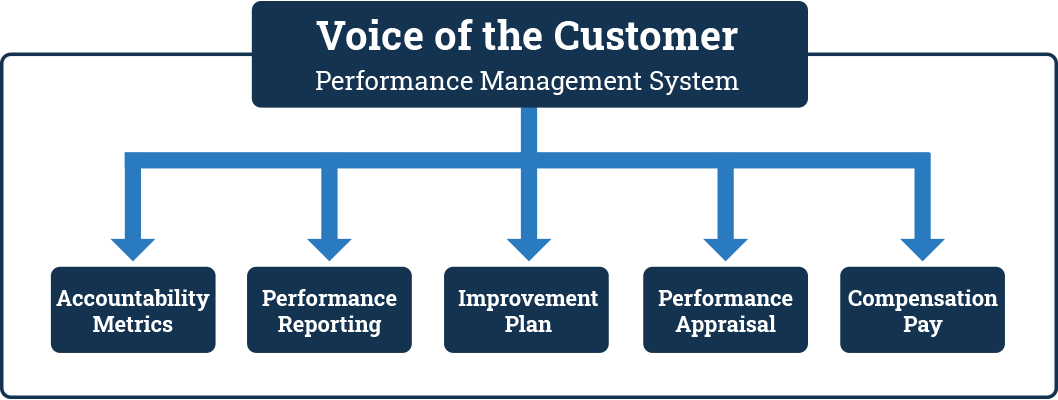
The Business Case for Agent VoC Performance Management
SQM has found that call centers that have implemented an Agent Voice of the Customer (VoC) Performance Management System have improved their First Call Resolution (FCR) and Customer Experience (CX) performance by as much as 10%. Moreover, this FCR improvement can occur in 30 days or less, even in large call centers. Also, for the average call center that SQM benchmarks, a 1% improvement in FCR equals $286,000 in annual operational savings.
Implementing a VoC Performance Management System has been one of the quickest ways to improve FCR and has provided the most significant increases in FCR performance. It has also been the most consistent best practice for improving FCR.
SQM’s research also shows that 28% of all inbound calls are repeat calls for the average call center. For repeat calls, the Agent is the source of error (SoE) 38% of the time, and for most call centers, the Agent is the second biggest SoE for not achieving FCR. When calls are unresolved, and the Agent is the SoE, "40% of the time it is a will issue", and "60% of the time it is a skill issue."
Interestingly, SQM's research shows that when the call center improves FCR, call resolution, and Csat, it results from reduced Agent FCR SoE. So again, the fastest way to improve FCR and call resolution is to create Agent call resolution accountability and motivation using a VoC Performance Management System.
About Agent VoC Performance Management System
Agent VoC Performance Management System uses VoC metrics such as FCR, call resolution, and Csat based on post-call survey data for creating Agent accountability, performance reporting, improvement plans, annual performance appraisals, and compensation pay.
Figure 1: Agent VoC Performance Management System


VoC Accountability Metrics
Most of our clients use a balanced scorecard approach for creating Agent accountability. Some of our clients who use a balanced scorecard have the metrics weighted towards VoC metrics, which we consider a best practice. There are five VoC metrics that SQM's call center clients typically use to create accountability at the Agent level. However, it is SQM's view that Agent Csat and Call Resolution are the most critical metrics to hold agents accountable for their performance. The following are the five common metrics used either independently or in combination to create Agent accountability for call center VoC performance:
For most call centers, a minimum call resolution or Csat target is for an Agent to be performing at their team level, an average improvement target is 1 to 4% percent higher, and an aggressive improvement target is 5% or higher. A best practice is to have individual Agent targets versus the same VoC metric targets for all Agents.

VoC Performance Reporting
An effective Agent VoC Performance Management System uses customer service management software. The software features include performance reporting for survey data capture, data analytics, data visualization, customizable dashboard, real-time notifications, and recorded customer feedback capabilities built right into the tool.
Most Agent VoC Performance Management Systems have a VoC dashboard to see survey results in real-time and easy-to-understand performance reporting. The VoC dashboard helps the Agent understand their VoC performance, targets, comparison of performance, and improvement opportunities. Agent VoC performance dashboard reporting should include the following information:
- Agent VoC performance
- Agent VoC metric targets
- How Agent compares to their team and call center performance
- Areas to improve call resolution and Csat
Customer service management software reporting should provide data analytics for assessing performance and identifying service and cost improvement opportunities from the Agent to the call center level. It is also essential for performance reporting to use a VoC Closed-loop process to identify, develop, check and act on customer service improvement opportunities at the Agent and call center level.

VoC Performance Improvement Plan
The VoC Performance Improvement Plan (PIP) is a process for dealing with Agents who have not performed to the call center's VoC standards. To begin, identify the bottom 15% of Agents who are performing poorly on the VoC metrics. Once this group has been identified, they need to be put on the VoC PIP to improve their VoC performance.
The goal of the VoC PIP is to have Agents understand and buy into the improvement plan and understand the consequences for not improving their VoC performance, which could include termination.
Five steps required for an effective VoC Performance Improvement Plan:
- Identify improvement metrics and reasons behind poor performance
- Engage Agent to get their perspective on poor performance
- Establish VoC improvement targets and how they will be measured
- Agree on training and support that will be provided to improve VoC metrics
- Review and discuss Agent progress weekly
VoC Performance Appraisal
When conducting annual Agent performance reviews, the appraisal form must be structured to convey what is truly important to the call center, what is expected of Agents, their performance, and opportunities for improvement. Additionally, for most call centers, the performance appraisal assessment is the basis for determining an Agent's eligibility for a merit pay increase, bonus dollars, and career advancement opportunities.
It is common for Agent performance appraisals to include customer surveys, call handling, quality assurance, and attendance data. Also, the Agent performance appraisal metrics used tend to be weighted equally. At SQM, we consider it a best practice for the VoC metrics (e.g., call resolution, Csat) to have a higher weighting than the other metrics being used in the Agent performance appraisal.
It is important to emphasize that supervisors need to encourage Agents that are average or below VoC performers to improve and reinforce high-performing Agents to maintain their high performance. The use of intrinsic rewards (e.g., personalized acknowledgment, opportunities for doing meaningful work, and personal development) can motivate Agents to improve call resolution and Csat performance.
Supervisors should discuss non-VoC metric performance with Agents, but the focus should be on VoC metrics performance. The below Agent performance appraisal steps apply to VoC (e.g., Csat, call resolution) and non-VoC metrics (e.g., AHT, QA, attendance).
The Agent performance appraisal feedback six steps are:
- Establish performance targets
- Communicate targets early and frequently
- Measure performance
- Compare performance to targets
- Discuss the Appraisal with the Agent
- Develop a mutually agreed-upon action plan

VoC Compensation Pay
A VoC Performance Management System uses extrinsic rewards (e.g., pay raises, bonuses, benefits) and intrinsic rewards (e.g., recognition for performing it well) to motivate Agents to achieve high Call resolution and Csat performance. This section focuses on extrinsic rewards.
Fair compensation does not mean all Agents at an organization are paid the same pay. Instead, fair compensation is paying Agents an appropriate amount according to their performance. For example, using VoC compensation pay is a fair compensation practice for call centers to retain and motivate Agents to improve call resolution and Csat performance.
SQM's research shows that call center bonus payout is approximately $2,000 per Agent, paid out quarterly or annually, with a high concentration of Agents (50% to 85%) receiving the $2,000 bonus. However, a best practice is to use quarterly payout installments and have the Agent bonus payout distribution weighted towards the higher-performing Agents for VoC metrics (e.g., call resolution and Csat results).
Agent annual bonus pay based on their VoC performance is:
- World class VoC performers (15%) = $4,000
- High-level VoC performers (45%) = $2,000
- Average VoC performers (25%) = $1,000
- Lowest VoC performers (15%) = $0
SQM's research shows that most call centers give an average merit pay increase of 3 percent to Agents. Most Agents expect an annual merit increase of 3 to 5%. However, a best practice is to have the Agent's annual merit pay increase weighted towards the higher-performing Agents. The Agent increase is based on VoC metrics (e.g., call resolution, Csat) and to use non-VoC metrics (e.g., AHT, QA) as a qualifier for a VoC merit increase. Agent annual merit pay increase based on their VoC performance is:
- World class VoC performers (15%) = 5%
- High-level VoC performers (45%) = 3 to 4%
- Average VoC performers (25%) = 2 to 3%
- Lowest VoC performers (15%) = 0 to 1%
VoC Performance Management System – Questions for Assessing Practices
- Do you use a VoC performance management system? If not, why not?
- Have you defined what a customer should experience when using your call center?
- What VoC metrics are Agents and supervisors held accountable for?
- Are performance metrics weighted? If so, are the VoC metrics weighted higher?
- Are Agents and supervisors held accountable for only one or two VoC metrics?
- Do your Agents and supervisors have access to VoC reporting?
- Does the performance reporting include VoC benchmarking?
- Do you provide Agents and supervisors with a VoC ranking?
- Do you use an internal and external integrated Agent reporting tool?
- Does your reporting include targets, rolling, and YTD VoC averages?
- Do you identify your bottom VoC performers?
- Do Agents understand/buy into the VoC PIP?
- Does your VoC PIP include a verbal warning, written warning, and termination process?
- Have any Agents ever been terminated due to poor VoC performance?
- Do you evaluate the financial impact of your poor Agent VoC performers?
- Do you hire extra Agents to replace the employees on a VoC PIP?
- Do you establish VoC and operational targets?
- Do you communicate VoC targets early and frequently?
- Do you provide ongoing VoC performance reviews?
- Do you provide VoC feedback opportunities (to and from the Agent)?
- Do your supervisors conduct effective semi-annual or annual Agent performance appraisals?
- Do Agents and supervisors receive merit pay increases based on VoC performance?
- Do Agents and supervisors receive bonus pay based on VoC performance?
- Does your Agent recognition program include intrinsic recognition to motivate Agents?
- Does your current bonus program motivate Agents to improve their VoC performance?
- Is the Agent bonus payout different among Agents?
- Is the Agent merit pay increases different among Agents?
- Do you use operational metrics as qualifiers for a merit pay increase or bonus?
- Is the bonus payout based on at least 50% for VoC performance?
Quick Related Links
First Call Resolution DefinitionFirst Call Resolution PPTEmployee Engagement First Call Resolution Operating Philosophy Call HandlingBest vs Worst Agents Agent Recognition Celebrating Agent SuccessQA Form Customer Quality Assurance Survey Data Calculate First Call Resolution RateWhat is a Good FCR Rate? VoC Closed-Loop Top 10 CX Metrics Agent Coaching and Recognition
